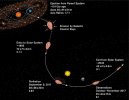Is the Interstellar Object 3I/ATLAS Alien Technology?
Today I co-authored an intriguing new paper with the brilliant collaborators Adam Hibberd and Adam Crowl from the
Initiative for Interstellar Studies in London, UK. The paper is accessible
here.
One of the solutions to Enrico Fermi’s question about extraterrestrials: “
where is everybody?” is offered by the
dark forest hypothesis, popularized by Cixin Liu’s science fiction novel “
The Dark Forest.” This hypothesis proposes that our cosmic neighborhood is dangerous, filled with intelligent civilizations that are hostile and silent to avoid detection by potential predators. In this context, the silence in searches for radio signals by the
SETI community is not caused by the lack of extraterrestrial intelligent civilizations, but is instead a consequence of them fearing mutual destruction.
Our paper explores the possibility that the recently discovered interstellar object,
3I/ATLAS, may provide evidence in support of the dark forest hypothesis. This new interstellar interloper has displayed a number of anomalous characteristics, some of which were summarized in
an essay that I wrote shortly after its discovery.
...
The near alignment of the retrograde trajectory of 3I/ATLAS with the ecliptic plane offers various benefits to an extraterrestrial intelligence, since it allows a spacecraft to access Earth with relative impunity. The eclipse of 3I/ATLAS by the Sun at perihelion for observers at Earth, would allow a spacecraft to conduct a clandestine reverse Solar Oberth maneuver, an optimal high-thrust strategy for interstellar spacecraft to brake and stay bound to the Sun. An optimal intercept of Earth would entail an arrival in late November or early December of 2025. Detection of a non-gravitational acceleration could also indicate an intent to intercept Jupiter, not far off the path of 3I/ATLAS, and a strategy to rendezvous with it after perihelion.



